Antarctic Birds Expedition
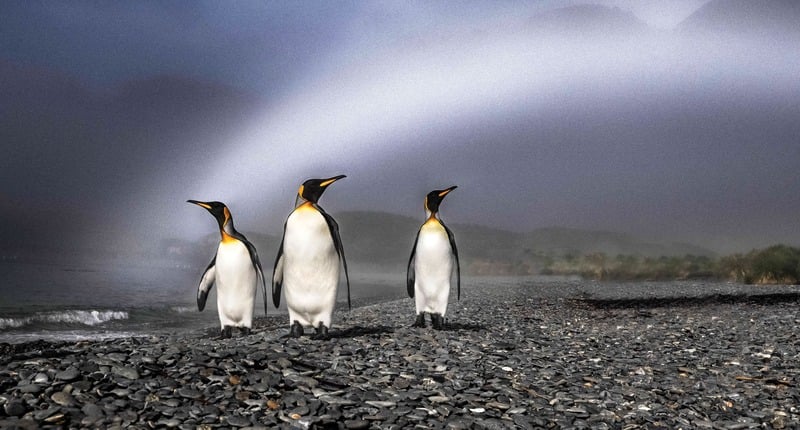
It’s a bucket-list item for real birders! With 62 bird species found in the Antarctic region, an Antarctic bird expedition is the ultimate treat for wildlife enthusiasts! Come aboard a small expedition ship and discover the avian paradise of the Antarctic region with world-famous ornithologists, professional photographers and guides!
Penguins
They’re the most iconic birds of Antarctica and many visitors dream of seeing them in their natural habitat! Penguins are not only extremely cute and photogenic, but very interesting to observe. They may appear clumsy on land, but have you ever seen a penguin dart through the waters? They are real torpedoes in tuxedos and great divers. During the breeding season penguin couples exhibit the most adorable mating behavior, gifting pebbles to their mates and building nests (and often stealing building materials from their neighbors).
From 17 penguin species worldwide, you’ll find eight species endemic to the Antarctic continent and the surrounding subantarctic islands (such as South Georgia Island, the South Sandwich Islands and the Falkland Islands). Plan your trip to Antarctica based on which penguin species you would like to see. Magellanic penguins can be found further north around the Falklands, crested penguins (such as rockhopper and macaroni penguins) can be found in great numbers on the subantarctic islands, as well as king penguins, which breed in large colonies (several million breeding pairs) on South Georgia. On the Antarctic Peninsula, you can expect adelie, gentoo and chinstrap penguins.
Gentoo Penguins
These 70-90cm (27-35 inch) fellows are great divers! They love to eat fish, crustaceans and squid and, while foraging, they can dive as deep as 200m (650 feet) below the water surface. Gentoos usually live around 15 to 20 years in the wild. Their breeding grounds are on the Antarctic Peninsula, the Falklands and the subantarctic islands, where they choose coastal regions to build their nests in grassy spots. Females usually lay two eggs and both males and females share parental duties during incubation.
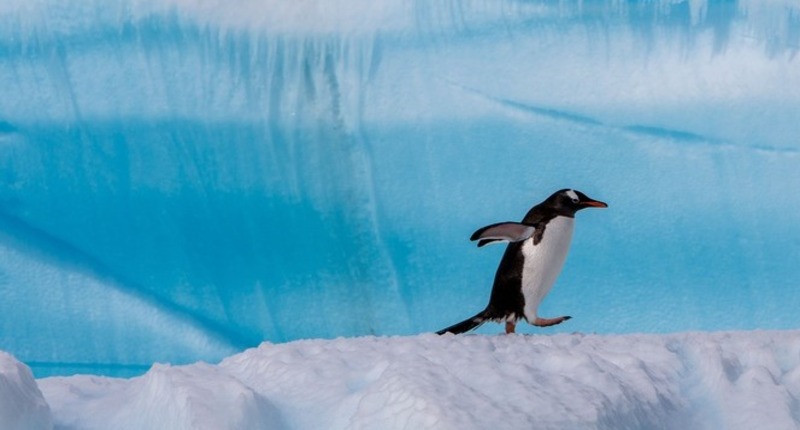
Magellanic Penguins
These penguins prefer the subantarctic regions. You can find their nesting grounds on the Falkland Islands and in South America (Chile and Argentina). Magellanic penguins like to burrow in the soil and prefer coastal areas with dense vegetation in order to hide from predators. They also are very shy around people and you’ll see them running once they spot you! Wild birds can live up to 25 years. In comparison to other penguin species, Magellanic penguins are rather small at around 60-75cm (24-30 inches) in height. Every year during breeding season, they return to the same mate, with males arriving earlier at the breeding sites to secure their burrows and fend off competitors. Once the females arrive, they find their mates by their specific calls!
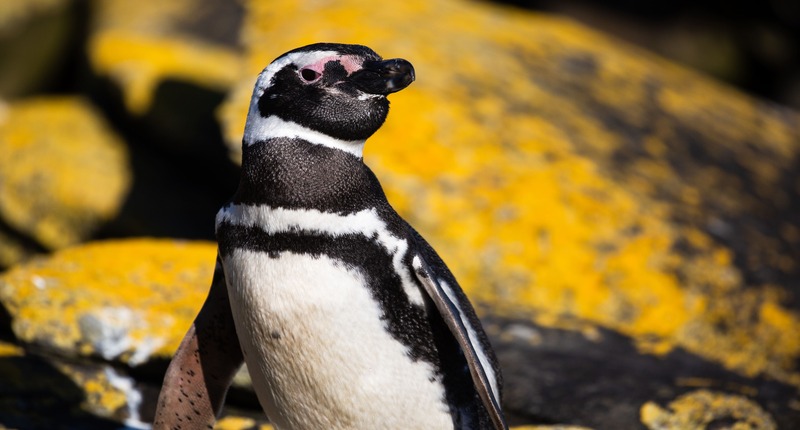
Rockhopper Penguins
Rockhoppers are among the smallest penguins at an average of 50cm (20 inches) in height. They prefer the rocky shores of the subantarctic islands, where you can see them in large colonies nesting on grassy shores. Their population has declined over the last three decades and they are currently an endangered species. In the wild, these penguins make it only to around 10 years of age.
%20(1).jpg)
Macaroni Penguins
Just like rockhoppers, macaroni penguins belong to the crested species. At up to 70cm (28 inches) in height, they are a little larger than rockhoppers. You can find their breeding sites on the subantarctic islands. English explorers may have given them their iconic name. They spotted these penguins in the 18th century and named them after the fashion icons of the time, the macaronis: young men with a flamboyant taste for flashy feathered hats. These birds have a lively and complex way of communicating by flapping their wings, nodding their heads and using their screeching voices.
%20(1).jpg)
Chinstrap Penguins
They’re the most abundant penguins in the world at an estimated seven million pairs. In the wild, they can reach up to 20 years of age. On Antarctic cruises, you can spot them easily from your expedition ship as they forage close to the shores of the continent and surrounding islands and on the pack ice. They have even been spotted floating the Southern Ocean on icebergs!
%20(1).jpg)
Adelie Penguins
Adelie penguins are real Antarctic dwellers! They thrive on the coastlines of the continent and the surrounding islands, breeding in large colonies. Around 2.5 million breeding pairs call Antarctica their home. Females lay two eggs each season and, after their chicks hatch, young Adelie penguin chicks join nurseries/crèches (like many other penguin species do as well) before heading out to sea.
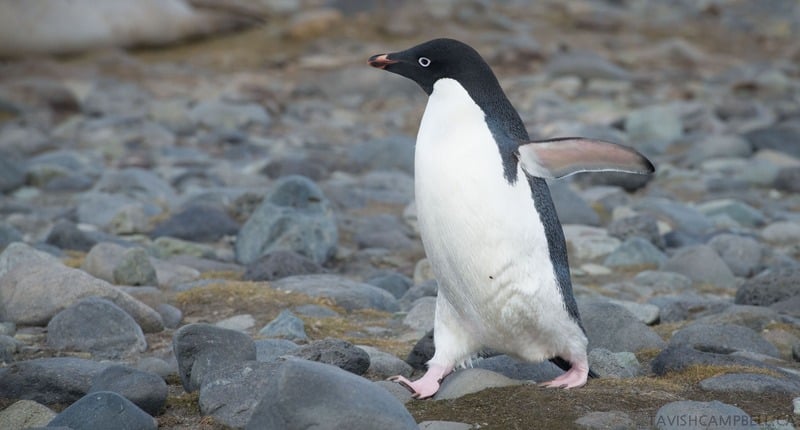
King Penguins
South Georgia Island is the perfect place to see King penguins, with an estimated 450,000 pairs (about half of the worldwide population)! As the second largest penguin in the world (after the emperor), they can reach a height of 94cm (37 inches). King penguins don’t have nests as they carry their eggs on their feet, covered by a skin fold. Their chicks are easy to spot with their brown fluffy appearance. After they shed the brownish fluff, they get their waterproof coats. As one of the greatest divers among penguins, they spend most of their lives at sea and can dive as deep as 300m (985 feet).
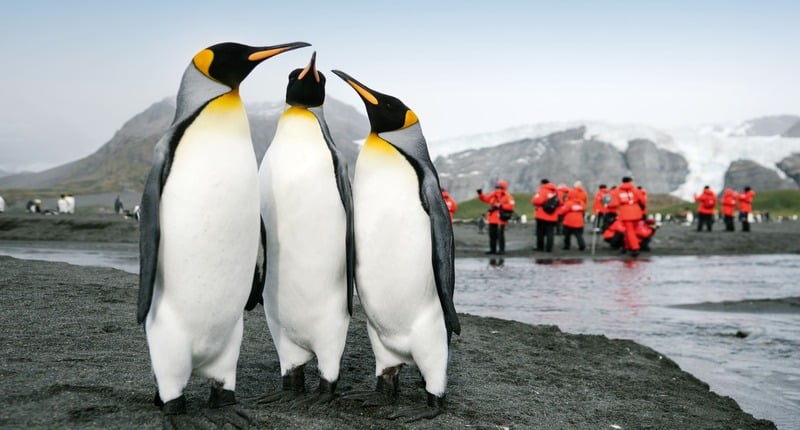
Emperor Penguins
Look for emperor penguins on the Antarctic continent! They are perfectly adapted to withstand the harsh conditions of Antarctica like -50C (-58F) temperatures and wind speeds of up to 200km/h (124mph). They are the largest penguin species, reaching up to 122cm (48 inches) in height. Females lay one egg, which they entrust their male partners for incubation, while they return to the ocean to feed. Emperor penguins are record divers, reaching depths of up to 450m (1,476 feet)!
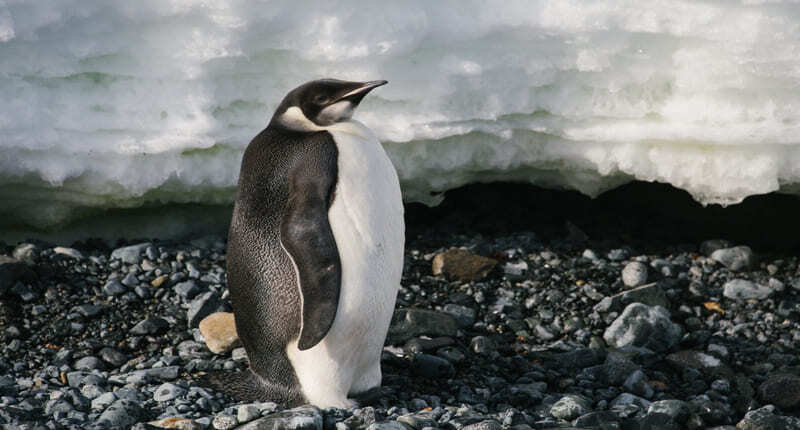
Albatrosses
Albatrosses are real long-haul travelers! The wandering albatross, the largest of its species with a wingspan up to 3.5 meters (11.5 feet), can journey from the planet’s sub-tropical regions to Antarctic waters, covering up to 1,000km (600 miles) per day. They can travel from 2,900 to 14,900 km (1,800 – 9,300 miles) in a single flight. Wandering albatrosses reach their breeding age at around seven years and spend most of their young lives at sea before that. Their prime breeding spots are the Antarctic and subantarctic islands between 46 and 56 degrees south latitude.
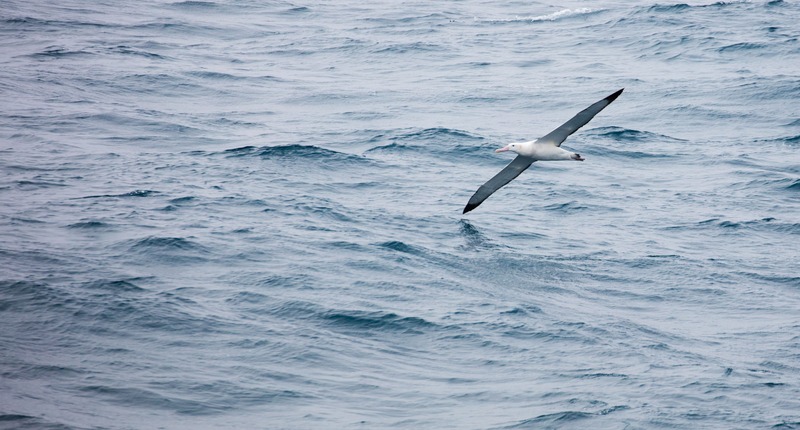
Want to know more about these majestic seabirds? Find out our top five facts about albatrosses:
- One egg at a time
Larger species of the albatross family are rather unproductive when it comes to offspring, with each pair brooding only one chick at a time and only every second year. Smaller species, in contrast, may breed annually. Their nests consist of mounds of grass, mud and feces.
- Built-in desalination
Their hooked bills filter saltwater! Spending most of their lives at sea, they are perfectly adapted to drink ocean water, using their glands to remove the salt and excrete it through tube-like passages in their beaks.
- They live long lives
The average lifespan is around 30 years, with some birds living into their 60s! Some of the females are even known to breed in their 60s.
- They (mostly) mate for life
Albatrosses form long-term bonds with each other, but with a little hanky-panky now and then. Raising their chicks around 165 days of the year, they separate after that until the next breeding meet-up. While they are monogamous for the most part, some individuals are known to breed outside their relationships.
- Perfect sense of smell
There’s a delicious fishmeal around 19km (12 miles) away? Not a problem for the average albatross to detect! They have a very keen sense of smell, which, combined with their good eyesight, is a crucial part of a successful feeding process.
Petrels
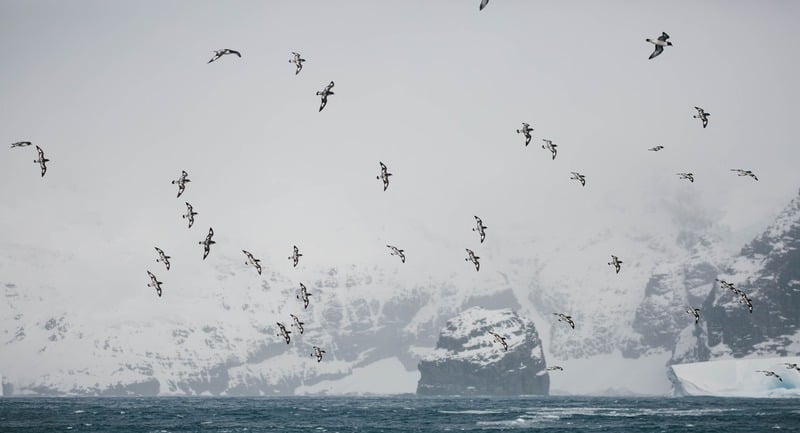
The petrel species covers various seabirds. In the petrel family, you can find snow petrels, diving petrels, southern giant petrels and other petrel types, as well as southern fulmars, Antarctic fulmars and shearwaters. You can spot their dense colonies around sea cliffs in Antarctica and on the subantarctic islands. Just like some other seabirds in Antarctica, they can excrete excess salt through the glands above their nasal passages. Petrels are also famous for their versatile foul-smelling stomach oil, which keeps them nourished on long flights, but is also used for feeding their young ones and repelling predators. And did you know that the snow petrel is only one of three birds that has been spotted on the geographic South Pole?
Giant Petrels
The southern giant petrel is found in Antarctica, but also in the subtropical regions of South America, Africa and Australia. With their brownish-grey appearance, giant petrels can reach up to 99cm (39 inches) in height with a wingspan of 205 m (81 inches)! They are aggressive and can kill other birds like penguins and skua chicks. They aren’t picky eaters. You can frequently spot them around fishing boats, scavenging for carrion and other leftovers.
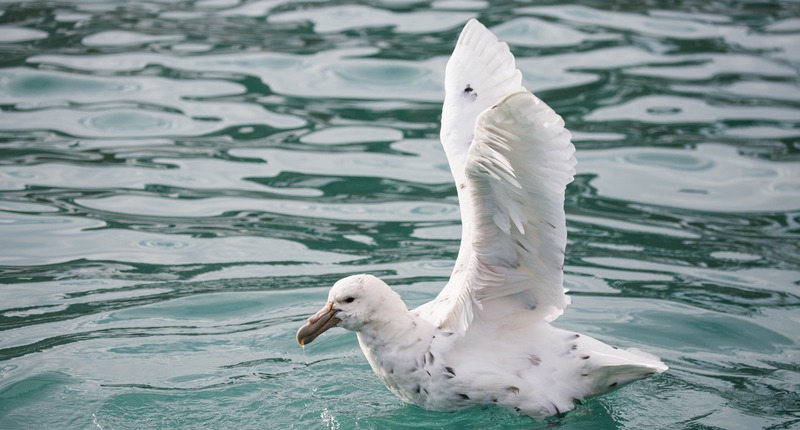
White-headed Petrels
These birds can breed in colonies or alone in burrows on the subantarctic islands. They mostly feed on squid, crustaceans and fish. White-headed petrels prefer to feed at night to avoid their predators (larger seabirds).
Antarctic Petrels
With their dark brown and white coats, you’ll spot them mostly in the Ross and Weddell Seas. Antarctic petrels feed on krill, squid and fish. They get their food while diving down from the air or water surface, but also just while floating on the water.
Atlantic Petrels
Its home is the South Atlantic Ocean, where it feeds on squid, fish and crustaceans. Atlantic petrels prefer high cliffs for their breeding spots, digging burrows in peaty soil and vegetation. You can spot them around Antarctica, as well as Tristan da Cunha, Brazil and Namibia.
Cape Petrels
You can find cape petrels on the subantarctic islands. Look for black heads and bills with white and black patches on their wings and bodies. While they breed around Antarctica, they may depart for the winter months and are found further north near the Galapagos Islands, Auckland Islands and Angola.
Great-Winged Petrels
Their plumage is dark or sooty brown with a lighter and greyer area around their bills. Great-winged petrels spend most of their lives at sea and only the breeding season drives them ashore. You can find them on the Antarctic and subantarctic islands.
Wilson's Storm Petrels
Wilson’s storm petrels have one of the widest-ranging habitats among seabirds on the planet. You can find them in Antarctica and in many other parts of the world, except the North Pacific and the Arctic. Their appearance is sooty grey to black with a white belt above the tail. Smaller in comparison to other petrels, they reach only about 16-18cm (6-7 inches) in size. These birds mainly feed on plankton, fish and krill.
Antarctic Terns
Easy to spot with their bright orange bills and legs, they are found on the subantarctic islands, as well as mainland Antarctica. Their bodies are white, with grey to black upper wings and a black area on the head and forehead. Adult birds can reach a length of up to 40cm (16 inches), with a wingspan of up to 75cm (30 inches). Antarctic terns usually fish in large flocks and cooperate if needed to defend their offspring from predators. While most terns breed in colonies, the Antarctic tern often chooses to nest on its own. Nests consist of pebbles, giving their eggs the perfect camouflage. Females usually lay between one and three eggs and parents share the incubation and feeding duties. In comparison to the Arctic tern, Antarctic terns have longer legs and less prominent dark markings.
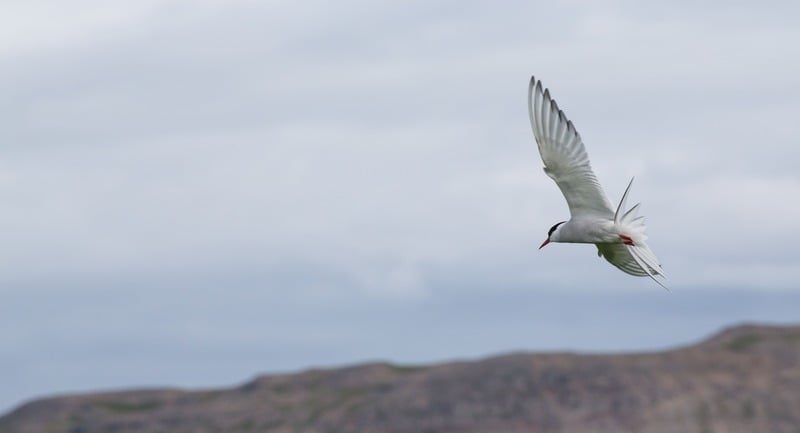
Antarctic Skuas
The Antarctic region is the habitat of two Antarctic skua species: the south polar skua and the brown skua. Both species feed around the islands off the continent, as well as on the Antarctic Peninsula. Both species feed on fish, squid, crustaceans, but also carrion, eggs and the chicks of other seabirds. Brown skuas are larger, with brown plumage, sharp bills, webbed feet and claws. South polar skuas are smaller and less bulky. During the breeding season, skua couples establish their territory and scrape a small hole into the ground to lay their eggs inside. During incubation, parents take turns: one stays with the offspring while the other forages for food. These birds are highly intelligent and remember people (especially scientists) they dislike! Breeding couples are sensitive to people coming too close to their nests. Skua attacks are not pleasant, but usually the loud warning calls will alert intruders well in advance.
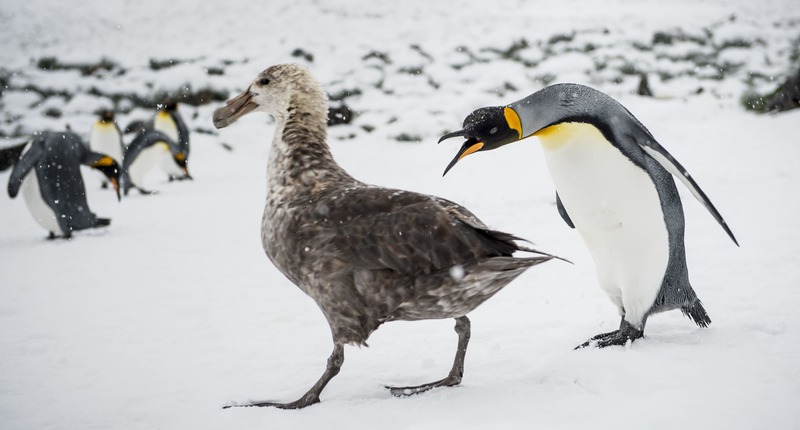
Antarctica Bird Watching Expeditions
If you are a bird lover, Antarctica is a must-visit and dream come true! Board a small expedition cruise with some of the best ornithologists and enjoy the variety of rare Antarctic birds. Learn everything you always wanted to know about your favorite birds and let professional photographers and guides help you make it one of the most memorable adventures of your life. Contact us and we’ll help you find the cruise that fits your adventurous spirit.
FAQs
What kind of birds live in Antarctica?
Many different species breed and thrive on and around the Antarctic continent. Here you can find flightless birds such as penguins, as well as many rare Antarctic seabirds (such as petrels, skuas, blue-eyed shags, the Antarctic blue-yes cormorant, kelp gulls and Antarctic shags), and other more common birds. The region is the perfect habitat for several species that are endangered and rare due to its remoteness and the abundance of Antarctic krill and fish.
What are the rarest birds in Antarctica?
Antarctica and the surrounding islands in the Southern Ocean are home to many rare birds. Among them, you can find various albatross species (such as the black-browed albatross), petrel species (such as white chinned petrels and Gould’s petrels) and, of course, penguins, which you can only find in the Southern Hemisphere.
What is the biggest bird in Antarctica?
The wandering albatross is the largest bird on the Antarctic continent. Wandering albatrosses are the only species in the world with a wingspan of 3.5 m (11.5 feet)!
What is the fastest bird in Antarctica?
The fastest among Antarctic birds is the grey-headed albatross. It’s a Guinness Book of World Records holder, clocked at 130km/h (80mph) and the fastest flying bird among all bird species on the planet.